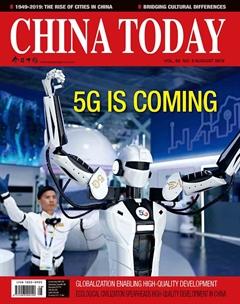1949-2019: The Rise of Cities in China
By LIU BAOKUI

URBANIZATION is an impor- tant indicator for measuring the degree of development and modernization of a country or region. Chinas urbanization is an epitome of the countrys development as a whole. It is a process of both unremitting explorations and institu- tional and model innovations based on local realities. Over the vicissitudes of 70 years since the Peoples Republic of China was founded in 1949, urbanization has transformed a “rural China” into an “urban China.” Having avoided serious social problems experienced by developed countries and many developing countries, China has explored a new approach to urbanization with Chinese characteristics.
First 30 Years: Twists and Turns of Exploring
When the Peoples Republic of China was founded in 1949, the urbanization rate was only 10.6 percent. After decades of armed conflicts, Chinese wartorn cities needed to be rebuilt, mostly from scratch. The Chinese government has long recognized the importance of urban areas in reviving the national economy and quickly shifted its focus to the city.
At the Second Plenary Session of the Seventh Central Committee of the Communist Party of China (CPC) held before the founding of the Peoples Republic of China, Chairman Mao Zedong pointed out that the government must shift priority from rural areas to urban areas. He called for great efforts in learning how to manage and build cities. His speech became the guiding principle for urbanization in the early years of the new China.
Most of the Chinese cities built and developed during feudal society were consumption-driven cities. They had no production capacity, nor did they have the ability to lead the development in vast rural areas. These cities were also relatively underdeveloped in terms of infrastructure, industries, and architectural styles.
After the PRC was founded, two main aspects of work were carried out. The first was to strengthen urban construction, especially infrastructure, such as roads, water supply, and housing. The second was to resume production, and change cities from being driven by consumption to be fueled by production. Revolving around the industrialization initiative, and combining major projects during the first Five-Year Plan period(1953-1957), a number of industrial cities were built.

